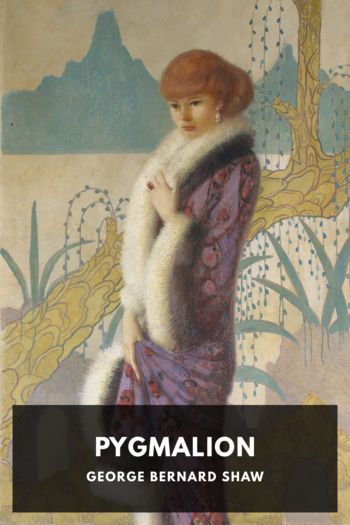Bulfinch’s Mythology Thomas Bulfinch (intellectual books to read TXT) 📖

- Author: Thomas Bulfinch
Book online «Bulfinch’s Mythology Thomas Bulfinch (intellectual books to read TXT) 📖». Author Thomas Bulfinch
2. The Historical theory; according to which all the persons mentioned in mythology were once real human beings, and the legends and fabulous traditions relating to them are merely the additions and embellishments of later times. Thus the story of Aeolus, the king and god of the winds, is supposed to have risen from the fact that Aeolus was the ruler of some islands in the Tyrrhenian Sea, where he reigned as a just and pious king, and taught the natives the use of sails for ships, and how to tell from the signs of the atmosphere the changes of the weather and the winds. Cadmus, who, the legend says, sowed the earth with dragon’s teeth, from which sprang a crop of armed men, was in fact an emigrant from Phoenicia, and brought with him into Greece the knowledge of the letters of the alphabet, which he taught to the natives. From these rudiments of learning sprung civilization, which the poets have always been prone to describe as a deterioration of man’s first estate, the Golden Age of innocence and simplicity.
3. The Allegorical theory supposes that all the myths of the ancients were allegorical and symbolical, and contained some moral, religious, or philosophical truth or historical fact, under the form of an allegory, but came in process of time to be understood literally. Thus Saturn, who devours his own children, is the same power whom the Greeks called Cronos (Time), which may truly be said to destroy whatever it has brought into existence. The story of Io is interpreted in a similar manner. Io is the moon, and Argus the starry sky, which, as it were, keeps sleepless watch over her. The fabulous wanderings of Io represent the continual revolutions of the moon, which also suggested to Milton the same idea.
“To behold the wandering moon
Riding near her highest noon,
Like one that had been led astray
In the heaven’s wide, pathless way.”
4. The Physical theory; according to which the elements of air, fire, and water were originally the objects of religious adoration, and the principal deities were personifications of the powers of nature. The transition was easy from a personification of the elements to the notion of supernatural beings presiding over and governing the different objects of nature. The Greeks, whose imagination was lively, peopled all nature with invisible beings, and supposed that every object, from the sun and sea to the smallest fountain and rivulet, was under the care of some particular divinity. Wordsworth, in his Excursion, has beautifully developed this view of Grecian mythology:
“In that fair clime the lonely herdsman, stretched
On the soft grass through half a summer’s day,
With music lulled his indolent repose;
And, in some fit of weariness, if he,
When his own breath was silent, chanced to hear
A distant strain far sweeter than the sounds
Which his poor skill could make, his fancy fetched
Even from the blazing chariot of the Sun
A beardless youth who touched a golden lute,
And filled the illumined groves with ravishment.
The mighty hunter, lifting up his eyes
Toward the crescent Moon, with grateful heart
Called on the lovely Wanderer who bestowed
That timely light to share his joyous sport;
And hence a beaming goddess with her nymphs
Across the lawn and through the darksome grove
(Not unaccompanied with tuneful notes
By echo multiplied from rock or cave)
Swept in the storm of chase, as moon and stars
Glance rapidly along the clouded heaven
When winds are blowing strong. The Traveller slaked
His thirst from rill or gushing fount, and thanked
The Naiad. Sunbeams upon distant hills
Gliding apace with shadows in their train,
Might with small help from fancy, be transformed
Into fleet Oreads sporting visibly.
The Zephyrs, fanning, as they passed, their wings,
Lacked not for love fair objects whom they wooed
With gentle whisper. Withered boughs grotesque,
Stripped of their leaves and twigs by hoary age,
From depth of shaggy covert peeping forth
In the low vale, or on steep mountain side;
And sometimes intermixed with stirring horns
Of the live deer, or goat’s depending beard;
These were the lurking Satyrs, a wild brood
Of gamesome deities; or Pan himself,
That simple shepherd’s awe-inspiring god.”
All the theories which have been mentioned are true to a certain extent. It would therefore be more correct to say that the mythology of a nation has sprung from all these sources combined than from any one in particular. We may add also that there are many myths which have arisen from the desire of man to account for those natural phenomena which he cannot understand; and not a few have had their rise from a similar desire of giving a reason for the names of places and persons.
Statues of the GodsTo adequately represent to the eye the ideas intended to be conveyed to the mind under the several names of deities was a task which called into exercise the highest powers of genius and art. Of the many attempts four have been most celebrated, the first two known to us only by the descriptions of the ancients, the others still extant and the acknowledged masterpieces of the sculptor’s art.
The Olympian JupiterThe statue of the Olympian Jupiter by Phidias was considered the highest achievement of this department of Grecian art. It was of colossal dimensions, and was what the ancients called “chryselephantine;” that is, composed of ivory and gold; the parts representing flesh being of ivory laid on a core of wood or stone, while the drapery and other ornaments were of gold. The height of the figure





Comments (0)